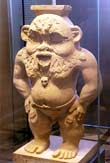
Short stature didn't prevent dwarves in ancient Egyptian culture from attaining high positions in society. Some served as assistants to the pharaoh, while others were looked up to as gods.
Chahira Kozma, a pediatrician at Georgetown University, examined remains and depictions of dwarves in ancient Egypt and concluded they were respected and that their disorder was not seen as a physical handicap.
The study was detailed in a Dec. 27 online version of the American Journal of Medical Genetics.
There are more than 100 known medical conditions that can lead to dwarfism. One of the most common is achondroplasia, a genetic disorder that affects approximately 1 in 30,000 children born each year.
In achondroplasia, the trunk of the body is of normal size, but the limbs are extremely short and the head tends to be unusually large. It's believed that achondroplasia was one of the most common causes of dwarfism in ancient Egypt.
Exotic Dancers ...
In the ancient necropolises of Giza and Saqqara, dwarves hailing from various professions were depicted on at least 50 tombs. They included jewelry makers, animal or pet handlers, fishermen, entertainers and dancers, nurses and midwives. Some held more important positions.
Sign up for the Live Science daily newsletter now
Get the world’s most fascinating discoveries delivered straight to your inbox.
"There were several elite dwarves, who worked for the pharaohs and had lavish burials," Kozma told LiveScience.
One dwarf, named Seneb, was one such "elite" dwarf and was honored with a lavish tomb in a royal cemetery close to the pyramids when he died.
The high value placed on dwarfs in ancient Egypt is highlighted by the praise and honor heaped upon Harkhuf, an army general and a high profile official who served two pharaohs, when he returned from an African expedition with precious treasures and a pygmy who performed exotic dances.
The child pharaoh at the time was so delighted by this last acquisition that he appointed people to guard the pygmy on his ship voyage back to Egypt, lest he fall into the water.
... and gods
Ancient Egyptians also worshipped several dwarf gods.
Ptah, a deity associated with regeneration and rejuvenation and who was also worshipped as the creator of the universe, was sometimes portrayed as a dwarf. Another god, Bes, was associated with love, sexuality and childbirth.
"Women during birth would shout to [Bes] to help them with delivery," Kozma said.
One particular prayer, called "the spell of the dwarf," was meant to be spoken four times over a clay dwarf by a woman in labor and went: "O good dwarf, come, because of the one who sent you...come down placenta, come down placenta, come down!"
Tolerance
In addition to dwarfism, the ancient Egyptians were tolerant of other genetic and medical disorders, Kozma said. The tomb of Tutankhamun, for example, contained a funeral gift depicting a female dwarf who also had bowed legs and clubbed feet.
In fact, a respect for the disabled was ingrained into the "wisdom teachings" of the culture. Amenemope, a wise man who lived during the New Kingdom, wrote that care for the old, the sick and the malformed was a moral duty.
"Man is clay and straw, the God is his builder," Amenemope wrote in a book of moral teachings. "The Wise Man should respect people affected by reversal of fortune."
- Scientists Find Prehistoric Dwarf Skeleton
- Scientists Build 'Frankenstein' Neanderthal Skeleton
- Egypt Unveils 2,500-Year-Old Tomb, Mummies
- 'Hobbit' Brain Reconstructed
- CSI: Egypt










